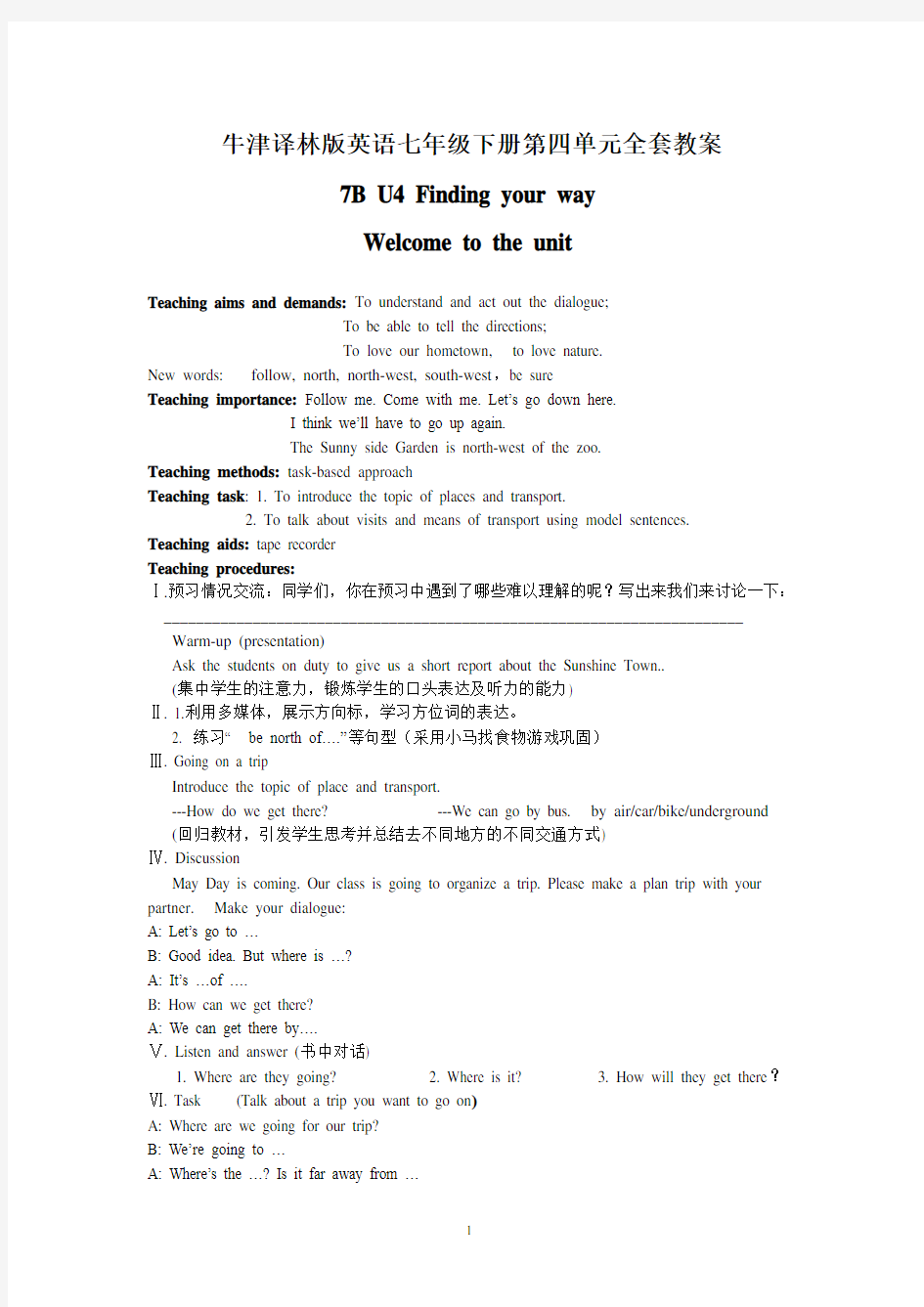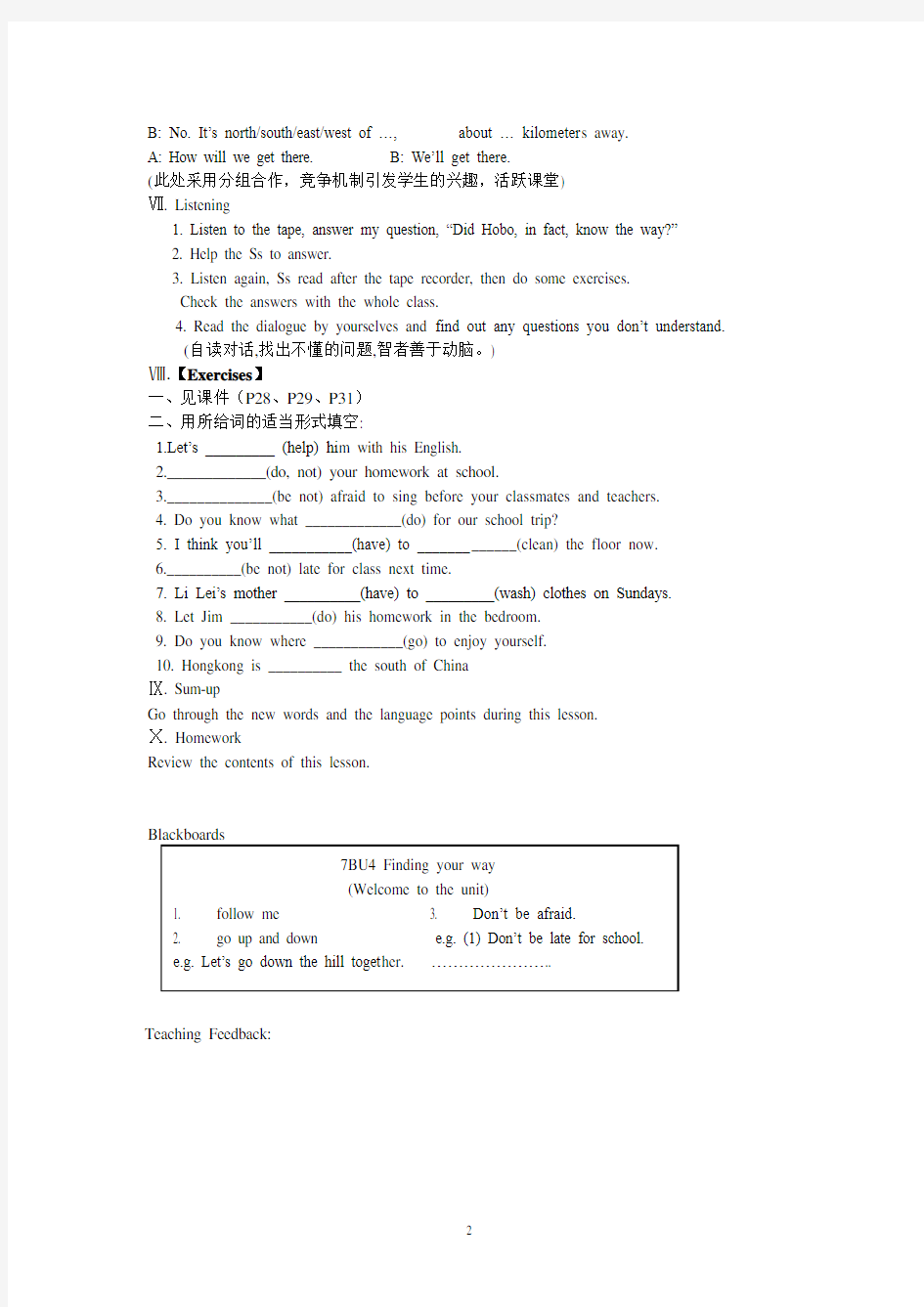牛津译林版英语七年级下册第四单元全套教案


牛津译林版英语七年级下册第四单元全套教案
7B U4 Finding your way
Welcome to the unit
Teaching aims and demands: To understand and act out the dialogue;
To be able to tell the directions;
To love our hometown, to love nature.
New words: follow, north, north-west, south-west,be sure
Teaching importance: Follow me. Come with me. Let’s go down here.
I think we’ll have to go up again.
The Sunny side Garden is north-west of the zoo.
Teaching methods: task-based approach
Teaching task: 1. To introduce the topic of places and transport.
2. To talk about visits and means of transport using model sentences.
Teaching aids: tape recorder
Teaching procedures:
Ⅰ.预习情况交流:同学们,你在预习中遇到了哪些难以理解的呢?写出来我们来讨论一下:________________________________________________________________________
Warm-up (presentation)
Ask the students on duty to give us a short report about the Sunshine Town..
(集中学生的注意力,锻炼学生的口头表达及听力的能力)
Ⅱ. 1.利用多媒体,展示方向标,学习方位词的表达。
2. 练习“ be north of….”等句型(采用小马找食物游戏巩固)
Ⅲ. Going on a trip
Introduce the topic of place and transport.
---How do we get there? ---We can go by bus. by air/car/bike/underground (回归教材,引发学生思考并总结去不同地方的不同交通方式)
Ⅳ. Discussion
May Day is coming. Our class is going to organize a trip. Please make a plan trip with your partner. Make your dialogue:
A: Let’s go to …
B: Good idea. But where is …?
A: It’s …of ….
B: How can we get there?
A: We can get there by….
Ⅴ. Listen and answer (书中对话)
1. Where are they going?
2. Where is it?
3. How will they get there?Ⅵ. Task (Talk about a trip you want to go on)
A: Where are we going for our trip?
B: We’re going to …
A: Where’s the …? Is it far away from …
B: No. It’s north/south/east/west of …, about … kilometer s away.
A: How will we get there. B: We’ll get there.
(此处采用分组合作,竞争机制引发学生的兴趣,活跃课堂)
Ⅶ. Listening
1. Listen to the tape, answer my question, “Did Hobo, in fact, know the way?”
2. Help the Ss to answer.
3. Listen again, Ss read after the tape recorder, then do some exercises.
Check the answers with the whole class.
4. Read the dialogue by yourselves and find out any questions you don’t understand.
(自读对话,找出不懂的问题,智者善于动脑。)
Ⅷ.【Exercises】
一、见课件(P28、P29、P31)
二、用所给词的适当形式填空:
1.Let’s _________ (help) hi m with his English.
2._____________(do, not) your homework at school.
3.______________(be not) afraid to sing before your classmates and teachers.
4. Do you know what _____________(do) for our school trip?
5. I think you’ll ___________(have) to _____________(clean) the floor now.
6.__________(be not) late for class next time.
7. Li Lei’s mother __________(have) to _________(wash) clothes on Sundays.
8. Let Jim ___________(do) his homework in the bedroom.
9. Do you know where ____________(go) to enjoy yourself.
10. Hongkong is __________ the south of China
Ⅸ. Sum-up
Go through the new words and the language points during this lesson.
Ⅹ. Homework
Review the contents of this lesson.
Teaching Feedback:
7B unit 4 Finding your way
Reading I
Teaching aims and demands:
New words: everybody, straight, bamboo, along, road, king, remember, dangerous,
sound, forest, funny, laugh, giraffe, quite, neck, leaf, north-east, bridge, cross Teaching methods: task-based approach
Teaching task:
1. Prepositions of movement..
2. Simple future tense with “shall” “will”
Teaching aids: tape recorder, tapes, slide projector, slides
Teaching procedures:
Ⅰ. Warm-up
Ask the Ss to give a free talk. .
Ⅱ.Listening
Now, listen to the text, please answer the questio n “Where are the students?”
Listen again, Ss read after the tape, and do some exercises.
Ⅲ. Reading
Ss read the articles by yourselves. Do the Ex on Part B2 and B3. Check the answers
with the whole class.
Ⅳ Language points:
1. turn right/left 向右/左拐
[点拨] turn在此句中作动词,“转弯”,“转向”。
He turned the car to the left, and stopped it at the corner.他把车左拐,把它停在角落里。[拓展] turn作动词还有“旋转”,“转动”,“翻转”,“使变质”,“使变成”等意思。
Please turn to Page 12.请翻到十二页。
The place turns into a park.
这地方变成了一座公园。
2. They like to eat bamboo and lie down all day long. 他们喜欢吃竹子,并整天地躺着。
[点拨]lie作动词,意思为“躺;摆放;位于”。其现在分词:lying;过去式:lay;lied;第三人称单数:lies;过去分词:lain;lied。
Jiangsu Province lies in the east of China.江苏省位于中国的东部。
There is a wallet lying on the ground.有个钱包在地上。
[拓展]lie还可以用作名词,意思为“谎言,谎话”。短语tell a lie“说谎”。
3. They make people laugh. 他们让人们大笑。
[点拨] make用作及物动词,意为“使;让”,在主动语态中其后要跟省略to的不定式作宾语补足语。短语make sb. do“让某人做某事”。
The music makes me feel good. 这个音乐让我感觉舒适。
The funny story makes all of us laugh. 这个有趣的故事使我们所有人都大笑了。
[拓展] 英语中,类似于make这种用法的动词还有let, have, hear, see, watch, notice, feel等。
如:
I see him put the key into the keyhole, turn it and open the door.
我看见他把钥匙插进锁孔,转动钥匙,然后打开了门。
I hear someone sing in the next room.
我听见有人在隔壁的房间唱歌。
Ⅴ.Discussion (task)
Have a discussion about the story.
Ⅵ.Sum-up
Go through the new words and the language points learnt during this lesson.
Ⅶ. Homework
Review the contents of this lesson.
教后记:
7B Unit4 Finding your way
Reading(2)
学习目标:
1、掌握文中出现的重点词组和句型。
2、能根据地图识路,掌握方位的基本表达方法。
3、能了解动物园常见动物的名称及基本习性。
4能为别人指路,能对他人指引的路线作出正确的反应。
重点难点:
重点词组:have to go up/ down walk straight to the traffic lights
like eating bamboo and lying down all day long the king of the animal world
remember to turn off the lights remember making a card for mother
make beautiful sounds make sb. do sth.
重点句型:Turn left at the third turning.=Take the third turning on the left.
Where are you going for the trip?
Walk past the post office, and you will see/ find the Panda House on the right.
There’s a bridge over the river.
There is a plane flying above me.
The square is north-west of the park.
Taiwan is in the south-east of China.
Japan is to the east of China.
【学习过程】
Self-learning
Preview the new words.
Listen to the tape.
Class activities
Step ⅠRevision
1. Play a game with the students to let them guess the animals.
2. Ask students to say something about the animals they have learned.
3. Ask the students to read and recite the text by themselves and complete B
4.
4. Invite some of the students to read the dialogue in roles.
Step ⅡPresentation
1. Write the important words and phrases on the blackboard: e.g. laugh, make sounds, leaf, clever and funny, lie down all day long……
2. Show a picture of B1 and help students to recall how to ask and show directions.
3. Make a summary of giving directions.
e.g. Go straight on and you’ll find…; Walk along the road; turn left/right; to the north of …; Cross the bridge, and you’ll see…
4. Encourage the students to put forward their own doubts and help them solve the difficulties.
Step Ⅲ Practice
1. Explain the language points and useful expressions.
Remember 的用法:
(1) remember to do sth. 记得去做某事(事情未做)
今晚别忘了给我打电话_________________________.
(2) remember doing sth. 记得做过某事(事情已做过)
我不记得说过那个了_____________________________.
<拓展>forget 作动词时的用法与remember 相同.
辨析noise , voice 与sound.
noise指刺耳,令人不悦的”噪音”,嘈杂声”; voice 指人的“嗓音”,如说话声、笑声、歌声,也指鸟的鸣叫声; sound指人耳能听到的各种“声音”
(1)不要吵闹,爸爸正在睡觉呢.Don’t______ _______. Father is ________now.
(2)我们可以听见鸟儿的鸣叫声. We can hear the _______ of the _______.
(3)那个女孩不声不响地进来了. The girl came in without _____ ______
all day long 的用法
All day long 意为”一整天” ,相当于the whole day . 例如:
我妈妈一整天都在打扫房间My mother ______ _______ the room _______ _________ ______________
2. Let students fill in the blanks according to the important phrases they learn in class to check if they know the text well.
3. Let the students retell the text with the key words and phrases.
Step Ⅳ Consolidation
Present the usage of the important phrases, explain them and present some examples
Step.V.Summary
the key phrases and sentences in the text.
Be able to retell the text in the students’ own words.
教学反思:
7B Unit 4 Finding your way
Integrated skills (P5)
教学目标:
能从听力材料中获取信息
能听懂指令并画出路线图,培养精听只能
能谈论如何到达特定的地点
教学重难点:
能从听力材料中获取信息
能谈论如何到达特定的地点
教学流程:
Step 1 复习
复习语法内容
Step 2 新课学习
A1)
1. 展示一些交通标志并让学生说出它们的意思。
2. 带学生看P49A1内容并为学生播放录音,指导他们带着问题听录音并完成练习。
3. 指导学生集体跟着录音朗读。然后,将班级分成两部分,分角色朗读对话。(提
醒学生注意语音语调)
4. 通过PPT让学生在此朗读句子(让学生记住介绍路线的方式)
A2)
在学习A1的基础上学习A2的内容
1.学生A2内容(让学生提取材料中的部分信息并让学生初排顺序)
2.一次听录音初排顺序,再次听录音整体排顺序。(学生报出答案老师校对)
3.再次播放录音,学生按照正确的顺序朗读,培养学生捕捉细节信息的能力,确
保学生完全理解每个句子,
Step 3 呈现
A3)
1.展示一幅纸上寻宝图或看谁先到终点的游戏图,让学生回忆自己玩游戏时的快
乐,激发他们的兴趣。
2. 告诉学生:The students are going on a treasure hunt. Simon and Daniel are in the
same group. They have a map. Let’s read the map on page 50 together. (板书
treasure 展示A3部分的寻宝图,老师问:What can you see in the map? 引
导学生说出some trees, a small river, small houses, some paths, some bridges等,
鼓励学生说出更多的信息)
3. 再次呈现A3部分的寻宝图,老师说:It’s your turn to find the treasure. Let’s try to
find the treasure in groups of four. Each group should draw the route on the map. If
you find the treasure, please mark it on the map.
4. 老师播放录音,让学生猜猜宝藏在什么地方。
5. 再次播放录音,学生四人组核对答案,然后全班核对答案。看看之前那个小组
的猜测是正确的,老师给予鼓励。
Step 4 展示
1.鼓励学生利用图片向大家介绍本小组寻宝路径。老师说:Now I want you to show
us the route. 鼓励学生勇于表达自己的观点。
2.对能力较强的学生,教师还可鼓励他们寻找其他寻宝路径。老师说:Now we have
a route to find the treasure. Who can show us another route?
Step 5 呈现
Speak up: How do I get there?
1. 读对话并回答问题(老师指导)
2. 再读对话并自己理解对话内容
3. 分角色朗读对话,并注意语音语调
4. 给学生充分的准备时间,之后安排不同层次的学生进行展示,老师及时表扬表演
好的一组
Step 6 家庭作业
1. 记忆本课所学词汇、词组和句型。
2. 背诵B部分的对话
3. 完成课课练
(Blackboard Design):
教学反思:
7B Unit 4 Finding your way
Study skills
教学目标
1.Learn about the falling tone and the rising tone.
2.Read the sentences with the right intonation.
3.Recognize the intonations of different sentences.
4.Tell the changes of the sentence meanings according to the change of the intonation.
教学重难点
1.Learn to use the intonations correctly.
2. Recognize the intonations of different sentences.
教学方法
通过这节课让学生了解英语的语调对句子意思表达的影响,教会学生运用正确的语音、语调来表达自己的意思。先从陈述句开始,容易朗读体会,让学生跟随录音操练,再用疑问句与学生对话,教师指导学生体会并总结朗读规律。
教学准备
Pictures,tape-recorder and multi-media
教学过程:
Step 1 Free talk
Step 2 Review
翻译短语与句子: 1.走过这房子2.沿着这条小路走3.在一个大树旁4.在地底下
5.在第三棵树前
6.一直走
7.在第一个拐角左转
8.在街道的拐角处
9.你将会看到红绿灯。You will see the traffic lights.
10.你可以从你住的大楼走到那儿去。You can walk there from your building.
(读最后两句话,注意语音与语调)
Step 3 Presentation
1. 教师让学生再找出几句本单元的陈述句,找到一句就让学生朗读,并在朗读过程中及
时纠正学生的语音,如:
The dog is under the bench.
Pandas are cute.
There is a beautiful lake in the park.
2. 让学生在朗读时体会陈述句的语调。
Step 4 Practice
Get the students to read more statements on Page 51. Remind them of the intonation patterns.
Play the tape for the students to follow.
Read the sentences one by one. Pay special attention to the intonation patterns.
总结:读陈述句时用降调。
Step 5 Presentation
教师用疑问句与学生就本单元的话题进行简单交流,注意使用正确的语调,让学生体会正确的语调。
Do you have a good time at school? Will you visit the zoo tomorrow?
Does the boy sit in front of you? What will you do on Sunday?
How many students are there in our class now?
Step 6 Practice
播放二、三组句子的录音,让学生模仿朗读,接着让部分学生朗读,教师注意及时纠正和表扬。再播放第四组对话的录音,让学生模仿朗读,之后,让学生告诉老师一些令人惊讶的事情,在交流时使用正确的语调。
总结:读一般疑问句时用升调,读特殊疑问句时用降调,表示惊讶时用升调。
Step 7 Practice (辨别句子的升降调)
Step 8 Read the dialogue
Get the students to read the dialogue on Page 51.
Get them to read the dialogue. Pay attention to the intonations patterns. Give the students 3-4 minute for them to read the dialogue to their partners.
Step 9 Exercises
Step 10 Homework
1.Read the passage in reading part in the right intonation.
2.Finish the exercises.
板书设计:
教学反思:
7B Unit4 Finding your way Task
教学目标:
A) 了解邀请函的写作格式。
B) 能在写邀请函的语境中组织信息并指明路线。
教学重难点:
“培养学生写作能力”是本课教学的重点。但是英语的口头表达提升到英语写作对与初一学生来说有一定的难度,所以“培养学生的写作能力”也是本课的难点。
教学方法:
《课堂教学论》认为“教师是学生学习的组织者和引导者”。所以我采取的教法是“创设情境法”,“演示法”,“讲练结合法”。“创设情境法”是用多媒体展现场景让学生身临其境,从而既能硬气学生的学英语下去,又能充分发挥学生的想象力,激发他们的表现欲望和创造热情。
“演示法”是教师和某一学生进行情景对话演示给其他学生看,从而给学生更直观的感官刺激,加深他们对英语对话的理解。
“讲练结合法”是针对学生难以理解的内容,教师采取先讲解在通过练习加以巩固的教法。教学流程:
1. Warming-up(让学生课前完成自主预习卡上的问题,检查预习效果,目的是引出邀请信中的时间、地点、人物等)
Teacher asks: When is your birthday?
Do you usually have a birthday party?
Where do you usually have a party?
Who do you usually invite?
How can I get to ….?
2. Make a short dialogue with your partner and act it out(多操练,以便学生更快掌握)
3. Listen to the invitation letter on page52 and fill in the blanks:
(训练听力,让task的教学不再局限于只是写作)
4. Read this invitation letter and ask students to find difficult words, phrases and sentences in groups, then explain them.(“小组合作法”是让学生在互帮互助的学习过程中感受集体的力量和魅力,学会运用集体的智慧解决问题。是学生的主要学习方法。)
5. More exercises
6. Show them how to write a letter in English and tell useful expressions.
7. Review directions and signs.
8. Suzy invites her friends to her home, but some of them don’t know the way. Please look at the map and help him to fill in the blanks, then draw the route together..(继续操练指路用语,对上几节课的巩固)
9. Next week you will have a birthday party. You want to invite some of your friends and classmates. Please write an invitation letter to them,give them ahout 8 minutes.(布置任务,让学生限时写作,课内掌握)
10.Ask two or three students to show us their invitation letters.(运用投影展示2-3名学生的作文,教师现场批阅,顺便总结易错词句的用法)
12. Homework : Finish another article after class.
教学反思:
